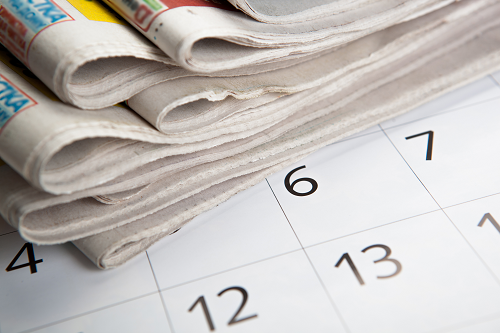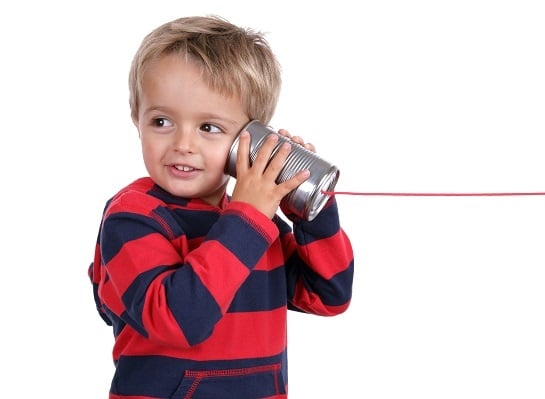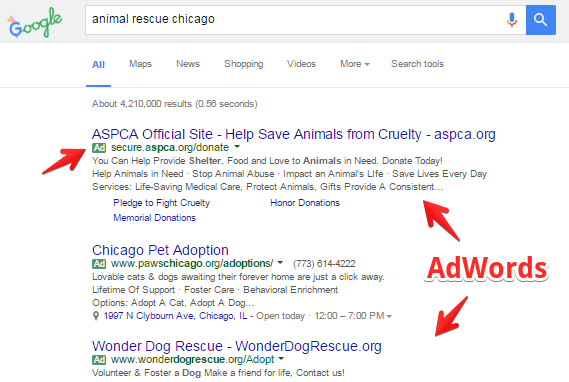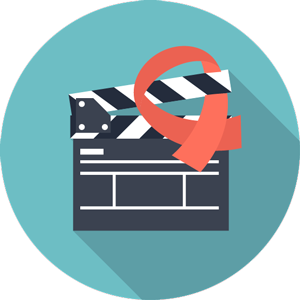Fall fundraising season is well underway, and chances are your organization has a fundraising event on the horizon. A key piece to your success is strategic promotion.
We all know events can be pricey, and when budgets get stretched thin, it’s tempting to put marketing efforts to the back burner. Fortunately, there are plenty of ways to spread the word that don’t cost a penny.
Here are 6 marketing strategies to promote your fundraising event for free:
- Google AdWords
- Other Online Resources (social media, organization website)
- Email Marketing
- Media Partners (media sponsorships, press coverage)
- Press Releases
- Local Events, Clubs and Word-of-Mouth
Whether you’re looking to make a big splash in a first year event, or need to refresh a stagnating event, bringing in new supporters can set the tone for years to come.
Read on for ways to convert these methods into more event registrations—and dollars for your cause.
{{cta(’30b75717-a932-4b13-bb55-8fc2c1d62608′)}}
1. Google Ads
Have you heard? Your nonprofit could be missing out on $10,000 every month in free online advertising from Google and not even know it.
The name of the game: Google Ad Grants, an initiative that awards thousands of dollars’ worth of in-kind advertising to nonprofits. The program, which has served over 20,000 nonprofits in 50 countries, was launched 13 years ago—meaning some eligible nonprofits have missed out on over $1.5 million in completely free advertising!
But it’s not too late for your nonprofit to benefit.
 What is a Google Ad Grant?
What is a Google Ad Grant?
Google Ad Grants are a program from search provider Google that give nonprofits the ability to create search result advertisements for free (up to $10,000 per month). When people search for related keywords, your ad will appear first in the sponsored section. You can use this to publicize your organization, cause or special event.
Even better, you can set the ads to show to local visitors who may never have heard of your cause, drawing more of the local community to your event.
Targeted marketing efforts like Google Ads have a much higher success rate. Plus, Google has built in analytical tools to help you find which keywords and descriptions are most effective.
Every time someone clicks on the ad, that costs your organization up to $2. Once you reach the $10,000 cap, your ad will be removed until next month.
How do I apply?
There are several requirements your nonprofit must meet in order to apply for a grant.
- Apply to Google for Nonprofits
- Be a certified 501(c)3 or hold valid charty status outside the U.S.
- Agree to Google’s terms of use regarding nondiscrimination and donation use
- Have a live website, as mentioned
- Not be heavily supported by a goverment funding (this can exclude institutitons like government entitites, hospitals, college and universities, but the philanthropic arms of schools may still be eligible).
For more see https://www.google.com/grants/eligibility.
How can my event benefit most from Google Ads?
There are a few best practices to keep in mind when creating a Google Ad. First, these ads, like all search results, are entirely text-based – no images or videos allowed. Your ad copy must be concise and evocative, plus abundantly clear on what viewers can expect if they click.
You also want to use popular search keywords in your ad. For more on Search Engine Optimization, see “What Is SEO and How Can It Help My Nonprofit?“.
Finally, you’ll need a website to which the ad will direct.
Note: You need to link to the same website each month to maintain eligibility. This means no switching back and forth between your event and organization websites.
The easy solution: Link to your organization website year-round. Then, when an event is coming up, simply create a landing page or put a prominent banner on the website (more on this in “Organization Website” below).
Do these search ads really work?
According to Community Boost Consulting, nonprofits taking advantage of Google Ad Grants get over 5,000 new website visitors, 3,400 new email subscribers, 300 volunteer applications and 450 program inquiries per month compared to previous performance.
One example; Annie Maxell, CEO of nonprofit Direct Relief International, reports on the site that one month of Google Ad Grants raised $59,000 in donations. Just one month with AdWords turned on allowed the organization to raise more than they’d collected online during the entire previous year!
We think this could be a game-changer not only your event, but year-round giving.
Get the full details on the program here: https://www.google.com/grants/
{{cta(‘17097454-4eac-4a50-8aaf-3c340b79fa91’)}}
2. Other Online Resources
While print flyers and mailings will always have a place for nonprofits, the Internet has revolutionized event promotion. Online marketing methods increase your reach exponentially.
Here’s a quick overview of how to use social media and website landing pages in event marketing.
Social Media
The “big three” social media platforms (Facebook, Twitter, LinkedIn) provide the perfect starting ground for your social campaign.
 1. Facebook.
1. Facebook.
Nearly all of your supporters and contact database have Facebook accounts.
Before your event, create a simple nonprofit Facebook Event featuring all the necessary information and registration links. Then periodically before the event (at least once a week), post updates regarding the event.
You can post auction item announcements, stories of the event’s impact, shout-outs to volunteers, sneak peeks of the venue, questions to the audience…any content that keeps potential attendees engaged with your cause.
{{cta(‘5724da45-484a-4c18-b48d-d58831525835′,’justifycenter’)}}
2. Twitter.
Create a unique, concise hashtag for your event (think #WinspireGala20XX) so followers can easily track event-related tweets in real time. Tweets with attached images stand out more, so include images of your featured auction items, last year’s event, the flyer and more.
 3. LinkedIn.
3. LinkedIn.
No longer is the professional networking site simply a medium for digital resumes and crisp headshots. More and more, LinkedIn members have been taking advantage of group posts and networking for an interactive experience.
To take advantage of these opportunities, try joining a local group (i.e. ‘Chicago Nonprofits’), then posting the invitation and important updates to the event.
Important note: You don’t want to be flagged as “spammy” and have people start ignoring your updates, or worse, remove you from the group altogether. Be sure to actively participate, post non-event-related discussion and respond to others’ posts as well.
These are your nonprofit professional and volunteer peers, and there’s a ton to learn from one another! Even better: Offering a discount code or incentive for LinkedIn members is a great way to get brand-new people introduced to your event.
{{cta(’55cbcb9e-f865-47b8-bc59-49f07a4b0037′,’justifycenter’)}}
Organization Website
Another very inexpensive way to promote your charity auction or gala is to leverage your existing organization’s website to point people to the event.
First, build a separate landing page devoted to your event. A landing page is the website where you’re directing all traffic related to the event. The landing page need not be as full-fledged or built out as your organization’s main page, but it needs to have relevant information. Common tabs include:
- Event Information
- Sponsor Information
- Auction Items / Link to online auction
- Media Gallery
- Donate
- Purchase Tickets
Also smart: Create a sliding banner on your charity’s homepage that directs people straight to the event landing page.
Finally, if you’re including an auction, promoting WOW!-worthy items early on (think a trip named in your honor in the Churchill Downs, or a 6-night golf adventure in Ireland) will build more traffic to your event site. Play up the unique Experience with photos, video and sensory descriptions.
Expert Tip: Create a Promotional Video on a Budget
Combining online event announcements with images helps get more interaction from your audience.
Video in particular conveys tons of information about your event in under a minute and leaps off the screen much more effectively than a text-only email or post. In fact, Hubspot reports a whopping one-third of all online activity is spent watching videos, while 80 percent of people remember video ads they viewed in the past month.
Having a great event video can be a game-changer for your organization.
If you don’t have a video on hand, ideally you would invest in a professional videographer and editor to produce a promotional piece for you. But if your marketing campaign is on a tight budget, try scouting student volunteers studying film production. You can contact professors of film classes at local colleges or night schools and see if your video could be worth class credit. Students are always looking to pad their resumes and portfolios, and in return you’ll have a quick and easy multimedia presentation to promote the event.
For help embedding an image in your website, see this step-by-step infographic.
3. Email Marketing
Despite the advent of social media channels over the last ten years, email is still a fundraising event’s primary promotion strategy. Emails are free or low-cost to send, are easy to track and garner instant responses.
The trick to an effective email campaign: having new, exciting content in each message.
To get the most out of your email campaign, check out our free eBook,{{cta(‘69998661-81b6-4fca-b0da-c49a286f9074’)}}. Get practical tips to:
- Choose an email service provider
- Keep the email campaign exciting each week
- Segment your audience
- Time your emails
- Plan out weekly emails (with a free customizable content calendar)
- …and more!
{{cta(‘661274c0-1d2e-4806-a547-596f67dbe59d’,’justifycenter’)}}
4. Media Partners
Work with local media outlets for coverage of your fall or winter event. This can be a little tricky for smaller nonprofits in major metropolitan cities, but never fear: There are many mediums to which you can submit a news release or advertisement that will be receptive to your event.
Free advertising
To get free ads, you’ll need to secure media sponsors.
Unlike your other corporate sponsors, media sponsorships can donate in-kind with advertising in their channel. You’ll feature their logo in your promotional materials and at the event, and in return they’ll promote your event on their channel.
When soliciting media sponsors, see if they can write off the monetary equivalent of their donation in taxes, which can sometimes encourage a bit more coverage. Even better: the more people that attend your event, the more impressions their logo and brand will receive. Talk about a win-win!
To make sponsorship acquisition easier, download our free sponsorship request letter templates and guide below:
{{cta(‘f2a7ad66-bc37-4f6f-ac57-1560c652588b’,’justifycenter’)}}
Press coverage
Free press coverage means the event is a story in and of itself. This is a huge opportunity and provides a totally unique perspective apart from an advertisement… as long as the press is good!
Check out just a few ideas of ways to get free mentions in the media.
- Radio. Reach out to your local radio stations for an interview during morning or afternoon drive times to promote your fundraiser. Schedule this 3-4 weeks ahead of your event to maximize exposure and listener response.
- Newspapers, magazines and blogs. Submit news releases either directly before or after the event. More tips on press releases directly below.
- Television. Work with your local television stations to secure a spot on a morning show. You, your executive director and/or a board member can talk for a few minutes about your charity and how the event will support your mission.
In all media spots, be sure to outline the nature and purpose of the event. Tie in the logistical details of your fundraiser, including a link to the registration or event page, and mention who would have a great time at your event.
5. Press releases
Press releases, also called news releases, are great to have prepared for any written mode of communication. You can submit a press release to newspapers, magazines, local bloggers, specialty publications, radio and TV stations and more.
The idea is to provide a press release giving these writers everything they need to write a story about your event. For best results, editors will be most interested in your story if there’s a newsworthy angle to your event.
Perhaps this year’s gala is hosted in a historic venue; the event raised a record amount of money; your organization is celebrating a special 30th anniversary; or a celebrity guest emcee or performer is scheduled to appear.
Find a balance between keeping the focus on the cause, and having a unique, exciting element to show off in a headline.
There are fairly stringent guidelines for the content and formatting of a proper press release. Check out the post below on how to create and distribute press releases and easily recreate your own.
{{cta(‘3c1fee8a-04ab-487f-9de0-2787224f3638′,’justifycenter’)}}
6. Local events and clubs

First, submit your event for posting on the city’s community calendar. You can find the calendar with a simple internet search; it may be embedded or linked to from your municipality’s website. (Don’t forget to share the event with neighboring community calendars as well.)
Next, use the calendar and other connections to find local events where you can quickly advertise the event. For example, at a sporting event, you could announce the event on the public address system. At a meeting of the local Rotary Club or other organizations, snag a minute or two on the program to invite people to the event and pass out flyers.
This tactic works even better if you can find special interest groups (i.e. a running club, or moms’ group) related to your event (i.e. a 5K, or school silent auction).
Bottom line: Equip staff, volunteers, community members, donors and past bidders with the materials they need to easily spread the word in their own circles. This might mean providing branded collateral, quarter-page flyers, promotional images and sound bites to your supporters.
As you can see, there are many different ways to promote an event for all budgets.
Benefit auctioneer specialist Danny Hooper noted in our recent webinar, “We’re finding a great transition going on right now at the events…The big supporters in the past are not the big supporters today.”
When you’ve gone to all the trouble of putting on a big production like a charity auction or gala, don’t settle for selling tickets to the same people year after year. If you can get creative and freshen up your event promotion efforts, attendance will grow to new heights.
{{cta(‘1a1cf4d1-a3b1-4e4c-8687-8512e667053f’,’justifycenter’)}}



 What is a Google Ad Grant?
What is a Google Ad Grant? 3. LinkedIn.
3. LinkedIn.
